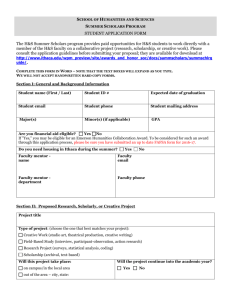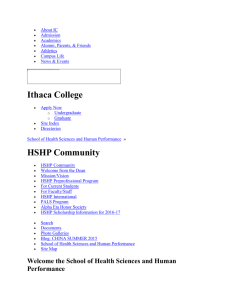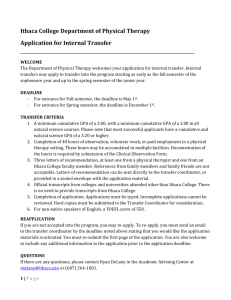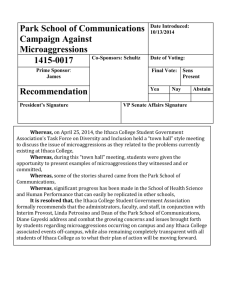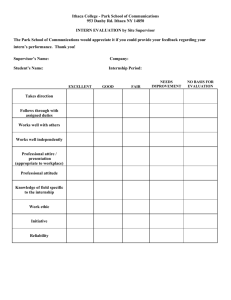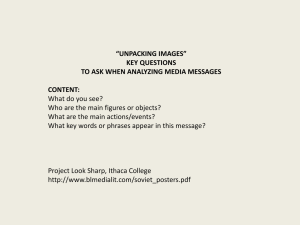Humanities and Sciences Faculty Position
advertisement
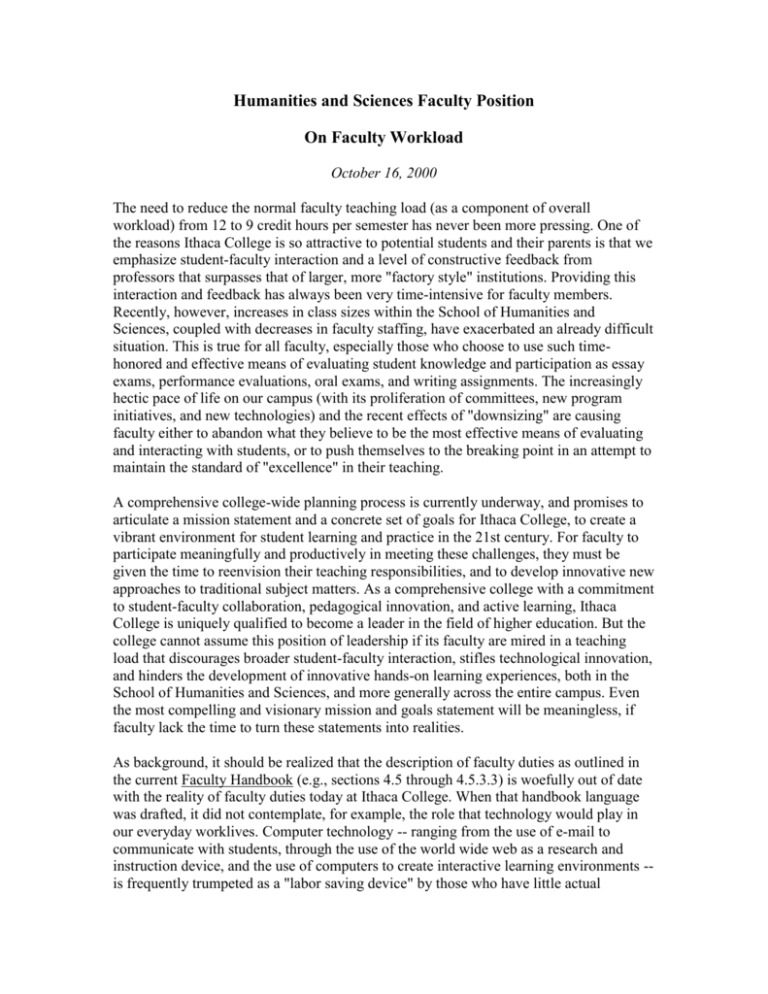
Humanities and Sciences Faculty Position On Faculty Workload October 16, 2000 The need to reduce the normal faculty teaching load (as a component of overall workload) from 12 to 9 credit hours per semester has never been more pressing. One of the reasons Ithaca College is so attractive to potential students and their parents is that we emphasize student-faculty interaction and a level of constructive feedback from professors that surpasses that of larger, more "factory style" institutions. Providing this interaction and feedback has always been very time-intensive for faculty members. Recently, however, increases in class sizes within the School of Humanities and Sciences, coupled with decreases in faculty staffing, have exacerbated an already difficult situation. This is true for all faculty, especially those who choose to use such timehonored and effective means of evaluating student knowledge and participation as essay exams, performance evaluations, oral exams, and writing assignments. The increasingly hectic pace of life on our campus (with its proliferation of committees, new program initiatives, and new technologies) and the recent effects of "downsizing" are causing faculty either to abandon what they believe to be the most effective means of evaluating and interacting with students, or to push themselves to the breaking point in an attempt to maintain the standard of "excellence" in their teaching. A comprehensive college-wide planning process is currently underway, and promises to articulate a mission statement and a concrete set of goals for Ithaca College, to create a vibrant environment for student learning and practice in the 21st century. For faculty to participate meaningfully and productively in meeting these challenges, they must be given the time to reenvision their teaching responsibilities, and to develop innovative new approaches to traditional subject matters. As a comprehensive college with a commitment to student-faculty collaboration, pedagogical innovation, and active learning, Ithaca College is uniquely qualified to become a leader in the field of higher education. But the college cannot assume this position of leadership if its faculty are mired in a teaching load that discourages broader student-faculty interaction, stifles technological innovation, and hinders the development of innovative hands-on learning experiences, both in the School of Humanities and Sciences, and more generally across the entire campus. Even the most compelling and visionary mission and goals statement will be meaningless, if faculty lack the time to turn these statements into realities. As background, it should be realized that the description of faculty duties as outlined in the current Faculty Handbook (e.g., sections 4.5 through 4.5.3.3) is woefully out of date with the reality of faculty duties today at Ithaca College. When that handbook language was drafted, it did not contemplate, for example, the role that technology would play in our everyday worklives. Computer technology -- ranging from the use of e-mail to communicate with students, through the use of the world wide web as a research and instruction device, and the use of computers to create interactive learning environments -is frequently trumpeted as a "labor saving device" by those who have little actual experience in using computers in academia. More accurately, computers should be characterized as labor-increasing devices, that also have the benefit of allowing us to teach in ways not possible in the traditional "lecture and discussion" format, and to teach subjects not possible using traditional teaching methods and materials. Faculty members today are not only expected to be their own typists; they are also expected to be familiar with rudimentary web design and research, basic digital image techniques, and the various uses of e-mail as a device by which to interact with students. The nature of the technology itself is rapidly and constantly evolving; as a result, learning and using this technology effectively is an ongoing task for most faculty members, who must frequently act as their own "tech support." There are tremendous benefits to be gained from the use of technology in teaching, but these benefits come with a hefty price tag: the time it takes faculty members to keep abreast of technological developments, and to adapt them to new and existing courses and projects. The College’s new mission statement places great emphasis on the role of "collaborative learning" at the Ithaca College of the future. Collaborative learning has long been the norm in the sciences and in psychology, where it represents a substantial piece of the workload, but a piece not described by a simplistic calculation of "credit hours generated." It is increasingly becoming the norm in the fine arts, social sciences, and humanities, where faculty members are attempting to infuse a greater degree of collaborative learning practices into their existing courses, and to develop new courses that allow students to participate actively in the learning experience. This type of teaching (for which many faculty members in the School of Humanities and Sciences were not explicitly hired) is frequently more time-consuming than the traditional "lecture-anddiscussion" class, requiring more preparation, more interaction, more assignments, and more feedback. Yet at precisely the moment when Ithaca College is preparing to embrace openly the "active, collaboratively learning model" as the core of its mission statement, faculty are saddled with a workload that discourages the kinds of innovations that "active, collaborative learning" demands. At the same time that teaching, through a confluence of the demands of technology and collaborative learning, has become more time-consuming, the service component of a faculty member’s workload has become more onerous. In the past there were relatively few committees doing the bulk of the college’s faculty governance business. Today the number of programs, committees, and subcommittees required to govern this institution properly has multiplied many times over, and virtually all of these programs, committees, and subcommittees need faculty participation. Yet there has been virtually no system of compensation implemented for this increase in service load; for many faculty members the extra service load has simply become an under-recognized "add-on" to the existing workload. As a result, these faculty members have been forced to take unilateral action: either bowing out of service almost completely (witness the many vacant seats on a variety of important committees, despite repeated calls for nominations), or decreasing the amount of time spent on teaching preparation. Neither alternative is good for the long-term health of this institution. The recently (re)insituted program of release/reassigned time, as implemented through the Provost’s Center for Faculty Development and Research, while a welcome addition to the College’s faculty development program, does little to alleviate the overall workload. Faculty members have long realized that the projects one must propose in order to receive "release time" are more time-consuming to carry out than simply teaching an extra section of a course would be. Nevertheless, the release time program provides the only currently available vehicle through which faculty members can even attempt to develop new courses, invent technologically innovative teaching methods, or further scholarly goals during a semester. Since it would serve the same function under a 9-9 credit hour teaching load, its role should be enhanced rather than reduced when Ithaca College moves to a lower teaching load, in order to encourage faculty members to develop cutting-edge courses, teaching strategies, and research. Finally, to secure the position of Ithaca College as a preeminent teaching institution, we need to attract and retain the most talented teachers and researchers to our faculty. For potential job applicants, Ithaca College suffers by comparison with institutions able to offer comparable salaries, research expectations, and service requirements, yet with lower teaching loads. We need to offer these people, as well as the talented and hard-working faculty already at Ithaca College, the time they need to do their most creative work, to assure the future health of our institution. The Senate appreciates the efforts being made by the College's administration-- such as its participation in the Pew workload study -- to support innovative attempts to reconfigure faculty workload. Nevertheless, because we do not consider significant increases in class size to be a viable option, we foresee no alternative to the hiring of new faculty members in order to accomplish the goal of reducing the normal faculty teaching load from 12 to 9 credit hours per semester. The exact number of new hires will depend upon a program-by-program evaluation of specific needs, but a figure of 40 new positions in the School of Humanities and Sciences, phased in incrementally over a period of five years, can serve as a rough estimate of the number of the new positions that will be necessary. Faculty members in the School of Humanities and Sciences have long done their "share" of keeping costs down, by working for below-average salaries, yet with above-average teaching loads. It is now time for the College to acknowledge these efforts, and to ensure a vital and creative faculty role in reshaping the institution's future, by reducing the normal faculty teaching load to 9 credit hours per semester.
